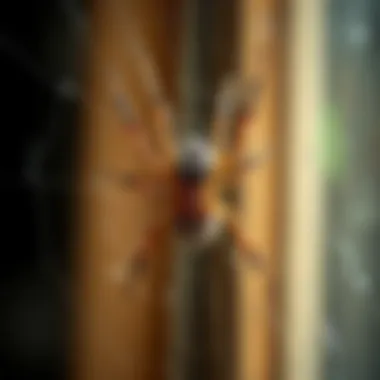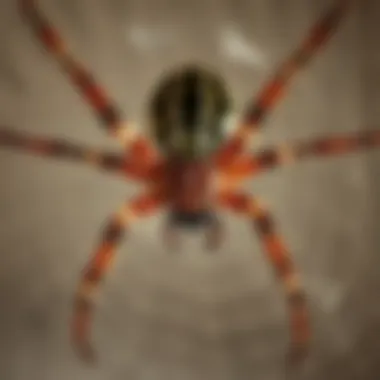Effective Strategies for Removing Spiders from Your Home


Intro
Spiders can make anyone’s skin crawl. Whether you're a housewife managing daily routines or a homeowner keen on keeping your space inviting, dealing with these eight-legged critters can feel like climbing a mountain barefoot. Understanding and addressing spider presence in your home involves a multifaceted approach—one that not only tackles removal but also emphasizes preventive measures. This article aims to provide practical advice for effectively managing spiders in your environment while acknowledging their role in the broader ecosystem. After all, not all spiders are villains; some offer invaluable pest control in nature.
Let’s delve into the nuts and bolts of identifying common household spiders, understand how to prevent their unwelcome returns, and explore tried-and-true methods for thoughtful removal. From knowing when to call a professional to the benefits of natural deterrents, we seek to arm you with the knowledge you need.
Pest Identification
Detailed descriptions of common pests
To manage spiders, the first step is identifying who you’re dealing with in your home. Common household varieties include the timid house spider, often brown and not larger than a quarter, and the black widow, sleek and shiny, known for its distinctive red hourglass shape. Each species comes with its unique behaviors and habitats:
- Common House Spider (Parasteatoda tepidariorum): These folks thrive in corners and amassed clutter; they are harmless but can spin webs quickly, making them a nuisance.
- Jumping Spider (Salticidae): These lively characters can leap distances multiple times their body lengths, showcasing personality while hunting. Their size ranges from tiny to a bit larger than a dime.
- Black Widow (Latrodectus mactans): Recognized by their glossy black color and a characteristic red mark on the abdomen, these spiders prefer undisturbed areas. Their bite is toxic but, thankfully, fatal outcomes are rare.
Signs and symptoms of infestations
Identifying a spider infestation goes beyond spotting the creatures themselves. Signs include:
- Visible webs: Cobwebs in less frequented areas like basements or attics indicate home for spiders.
- Egg sacs: They can often be found in hidden spots, presenting potential future inhabitants.
- Droppings: Small dark specks across surfaces can reveal their presence.
"Recognizing spider signals can significantly enhance your ability to respond swiftly and efficiently."
Prevention Strategies
Home maintenance tips for pest prevention
Maintaining your home doesn’t just keep it tidy—it can directly ward off spiders. Here are a few key strategies:
- Seal entry points: Cracks around windows, doors, and even tiny gaps can be highways for spiders. Use caulk or weather stripping to seal these entryways.
- Declutter: Spiders love dark, undisturbed places. By organizing your belongings, you limit their hiding spots. This is especially crucial in basements and garages.
- Regular cleaning: Vacuuming often can help keep webs at bay. Pay extra attention to corners and baseboards.
Natural deterrents and barriers
If you're looking into natural deterrents, several options exist:
- Peppermint oil: Spiders dislike the strong scent. Mix water with a few drops and spray it around entry points and corners.
- Vinegar solutions: A mix of vinegar and water can repel spiders. Spray it in the nooks and crannies where spiders tend to lay low.
- Cedar shavings: It’s a practical option for potential deterrent, as spiders avoid areas infused with its smell.
Treatment Options
Overview of chemical vs. natural treatments
When spiders make themselves at home, knowing your treatment options is crucial. Chemical solutions can prove effective but often come with risks. On the flip side, natural options are typically safer but may require more frequent application. The choice between the two depends on individual tolerance and the extent of the issue.
Step-by-step guides for DIY treatments
For those feeling adventurous enough to tackle it independently, here’s how to concoct your spider-fighting mixtures:
- Peppermint Spray: Mix 10 to 15 drops of peppermint essential oil with 2 cups of water in a spray bottle. Shake well before use. Spray around windows, doors, and corners.
- Vinegar Solution: Blend equal parts of vinegar and water in a spray bottle. Apply generously in spider-prone areas.
- Trap Method: Position a jar or bowl filled with soapy water in areas where you've noticed spider activity. The soap breaks the surface tension, leading to a sticky end for curious spiders.
All in all, these strategies are not mere suggestions; they are thoughtful steps towards reclaiming your home from unwelcome visitors. Each tip is rooted in practical application, ensuring even the most novice homeowner can effectively combat spiders. By mastering the art of prevention and removal, you will not only keep your space clean but also respect the natural balance of the ecosystem.
For further reading on pest control, consider checking CDC's pest control guidelines or browse through EPA on pest management.
Ultimately, tackling those little critters isn’t just about fear; it’s about creating a harmonious living space suitable for everyone.
Prolusion to Spider Control
When you step into your living room and find a web dangling from the corner, it can send chills down your spine. Spiders, whether you find them adorable or creepy, undoubtedly play a role in our homes. Understanding how to effectively control their presence is essential for homeowners and renters alike. Managing spider populations not only protects your living space from unexpected visitors but it also helps maintain a certain level of comfort in your home.


Understanding the Importance of Spider Management
Spider management shouldn't be seen merely as a necessity to keep your space tidy; it's about ensuring the health of your living environment. An uncontrolled spider population might signal a more pressing issue, such as an increase in other pests. Moreover, maintaining a spider-free zone helps alleviate the anxiety that can arise from their sudden appearances.
A balanced approach to spider control promotes peace of mind, understanding that these eight-legged creatures are part of a broader ecosystem.
Common Myths About Spiders
There are plenty of misconceptions about our eight-legged friends. One popular myth is that all spiders are dangerous; however, most species present no threat to humans. In fact, many spiders can be quite beneficial, consuming pests like mosquitoes and flies that can plague our homes. Another misconception is that if a spider is spotted, it suggests an infestation. Sometimes, it’s merely a matter of a wandering visitor taking a wrong turn.
"Spiders are more afraid of you than you are of them."
This saying emphasizes their natural tendencies to steer clear of human interaction. By dispelling these myths, we can approach spider control with a more informed perspective, leading to more effective and educated methods of removal.
Identifying Common Household Spiders
When tackling the issue of spiders in our living spaces, understanding the various household spider species is essential. Knowing who you’re dealing with not only aids in effective removal but also contributes towards better prevention. Each spider species behaves differently and presents varying levels of risk or benefit within your home. For instance, some spiders are harmless and may even contribute to reducing other pest populations, while others can induce fear or anxiety in residents.
Characteristics of Common Spiders
Household spiders encompass a varied bunch, with dozens of species potentially lurking in corners and crevices. Here are some of the more commonly found ones:
- Domestic House Spider: Often brownish or gray, this spider tends to create unsightly webs in undisturbed areas. They are usually small and not particularly aggressive, thriving on small insects.
- Black Widow: This infamous spider is recognized by its shiny, black body and red hourglass mark. While their bite can be harmful, they typically shy away from humans, preferring dimly lit spaces.
- Brown Recluse: Another spider to watch for, the brown recluse has a violin-shaped mark on its back. They also prefer secluded areas and their bite may lead to serious skin reactions, so caution is warranted.
- Wolf Spider: With its impressive hunting skills, the wolf spider doesn’t spin webs. Instead, it hunts down its prey. They are large and hairy but generally harmless to humans.
Identifying these spiders involves looking at their size, color, body shape, and web-building habits. Familiarity with these characteristics can lead to targeted removal strategies and help minimize panic. If you find a spider and are unsure of its identity, a quick search on reputable sources like Wikipedia or Britannica can provide clarity.
Benefits of Spiders in the Ecosystem
Many may not realize that spiders play a crucial role in maintaining the ecological balance within our homes and gardens. Here’s a brief look at the positive contributions they make:
- Pest Control: Spiders are natural predators. They feast on pests like flies, mosquitoes, and cockroaches, helping to keep their populations in check.
- Biodiversity Indicators: The presence of spiders in your environment often suggests a balanced ecosystem. They contribute to fostering diverse insect populations, which can benefit your garden.
- Food Source: While they might send shivers down your spine, spiders serve as a food source for many birds, small mammals, and other insects. This interdependence illustrates the complex relationships within ecosystems.
"Spiders are the unsung heroes of the garden, keeping more harmful pests at bay while maintaining balance within the ecosystem."
Understanding these characteristics and benefits allows homeowners to make informed decisions about handling spider situations. Rather than resorting immediately to extermination, it may be worth exploring coexistence strategies, especially for those harmless household spiders. By grasping both their negative perceptions and positive roles, we can approach spider management with a more thoughtful perspective.
Assessing Spider Infestation Levels
Understanding the level of spider infestation in your home is pivotal for effective removal and long-term management strategies. You can't tackle a problem if you're unaware of its scale. Not every spider seen scuttling across the floor indicates a burgeoning infestation. By assessing spider presence and evaluating the severity of an infestation, homeowners can tailor their approaches to suit their specific situation, ensuring that they don't go overboard or under-react.
Signs of Spider Presence
Recognizing the signs that spiders have taken up residence is the first step in assessment. Observing these signs can save time in your efforts:
- Visual Sightings: The most straightforward indication. A web, with its intricate patterns, is a hallmark of spider activity.
- Silken Threads: Look closely at corners, ceilings, and dark nooks. If you spot thin webs, it's a pretty solid sign that spiders are nearby.
- Egg Sacs: Not all spiders show themselves openly; hidden egg sacs are often a silent herald of future residents.
- Fecal Matter: Small brown or black specks may appear in areas where spiders dwell, resembling tiny droppings. This can help confirm active inhabitants.
- Decreased Pest Population: An unexpected drop in other pests can sometimes indicate an increase in spider population. They feed on a variety of insects, and fewer insects can often mean that spiders are doing their job.
These signs can help you gauge where to focus your observation. If you notice consistent signs in a specific area, it might be wise to examine that region more closely.
Evaluating Infestation Severity
Once you've identified the signs, the next step is to evaluate how severe the infestation might be. Not all spiders are created equal—some species pose more of a nuisance than others.
- Calculate the Frequency of Sightings: If you're seeing a few spiders occasionally, you might be in the clear. But if you're finding them daily, it's time to take action.
- Location Matters: Are the spiders confined to a single room, or are they spreading throughout your home? A single corner might not necessitate immediate action, while wider distribution could require more rigorous measures.
- Species Identification: Certain spiders, like the common house spider, are relatively harmless. But if you encounter species like the black widow or brown recluse, it’s critical to act promptly. Understanding the species you’re dealing with aids in determining the level of threat and appropriate response.
- Web Density: A higher density of webs might indicate a thriving spider community, revealing a greater need for intervention.
By methodically approaching assessment, house owners can avoid jumping to conclusions or missing out on addressing a genuine problem. This careful evaluation underpins all future actions—whether it's sealing entry points, cleaning, or employing traps or professional help. For effective management of spider populations, being proactive and aware is not just a good practice; it’s a necessity.
Preventive Measures for Spider Control
Taking control of spider populations in your home is a task that requires a proactive approach rather than a reactive one. Effective measures help not just in eliminating existing spiders but also in preventing new ones from setting up shop inside your living space. This section will explore different tactics that homeowners can employ to minimize encounters with spiders and create an unfriendly environment for them.
Sealing Entry Points
One significant aspect of spider prevention involves sealing off potential entry points around your home. Spiders are often unwelcome visitors that slip in through cracks and gaps. You’d be surprised at how much can fit through a space the size of a dime. Pay particular attention to areas such as window frames, doors, and even dryer vents.


- Caulking: Use caulk to fill in gaps and cracks in walls, especially around windows and doors. This not only blocks spiders but also helps with energy efficiency.
- Weather stripping: Ensure your doors and windows close tightly. Install weather stripping if necessary, which can act as an additional barrier.
- Screens: Fixed screens on windows and vents can keep both spiders and other types of insects out.
Sealing off these entryways addresses the problem at the source, meaning fewer spiders will invade your space.
Utilizing Natural Deterrents
Moving on to natural deterrents, which can be a more homeowner-friendly and environmentally conscious way of preventing spider encounters. There are several common items found around the house that spiders tend to dislike. This can save you from the hassle of chemical repellents.
- Essential oils: Scents like peppermint, tea tree, and eucalyptus are known to repel spiders. Mixing a few drops with water in a spray bottle provides an easy-to-use deterrent. Regularly spray around baseboards, entry points, and areas prone to spider activity.
- Vinegar: A mixture of equal parts vinegar and water can create a spray that wards off spiders. It’s also useful for cleaning.
- Citrus peels: Placing orange or lemon peels in corners of rooms or closets can deter spiders and leave a pleasant aroma.
These natural deterrents can significantly reduce spider sightings without imposing on your indoor air quality.
Maintaining Cleanliness
Finally, maintaining cleanliness in and around your home cannot be overstated. A tidy house is less appealing to spiders and the pests they prey upon. By eliminating their food sources and potential nesting spots, you weaken their chances of survival.
- Regular cleaning: Dust regularly and vacuum corners, crevices, and under furniture where spiders can hide. Disposing of spider webs immediately can also discourage reoccupation from spiders.
- Declutter: Reduce clutter inside your home, particularly in basements, attics, and garages. The more items cluttering these spaces, the more attractive the environment is to spiders.
- Yard maintenance: Keep outdoor areas clean as well, by trimming back shrubs, removing debris, and mowing the lawn regularly, thus cutting down on spiders’ preferred habitats.
Each step taken to maintain a clean environment helps in creating a hostile environment for spiders, reducing the chances of an infestation even further.
Remember: Prevention is always easier than removal. By putting these measures in practice, you create a home that is less inviting to spiders and other pests.
Removing Spiders from Your Home
Removing spiders from your living space is not just about overcoming an unpleasant encounter; it’s about fostering an environment that encourages comfort and wellbeing. Spiders can evoke fear and anxiety in many individuals. Therefore, knowing how to effectively manage their presence can greatly reduce those feelings. Additionally, certain spiders can pose health risks, making it important to distinguish between harmless and harmful species. This section delves into various strategies and techniques for removing spiders safely, ensuring that you can reclaim your home without resorting to potentially harmful chemicals or extreme measures.
Safe Removal Techniques
When it comes to removing spiders, it’s essential to prioritize methods that ensure both your safety and the spider's humane treatment. Factors like your temperament towards these creatures, the specific species present, and individual household decisions all play a significant role.
- Catch and Release: One of the most effective ways to remove spiders is through the classic catch-and-release method. Using a jar and a piece of paper, trap the spider and gently slide the paper under the jar. Once contained, take it outside and release it away from your home.
- Vacuum Cleaners: A vacuum cleaner can do wonders here, but it's important to use it cautiously. Place a sock or cloth over the end of the hose to capture the spider inside without harming it. After vacuuming, immediately take the attachment outside to release the spider.
Utilizing these methods helps maintain balance in the ecosystem; spiders play a crucial role in controlling insect populations.
Using Traps and Baits
For those folks feeling a bit squeamish about direct contact, traps and baits present a viable alternative. These devices can help manage spider populations effectively without having to face the eight-legged critters directly.
- Sticky Traps: These are commercially available and are a popular choice for capturing spiders. Place them in corners, behind furniture, or in areas where you’ve noticed spider activity. The adhesive surface captures spiders when they venture onto the trap.
- Natural Bait: Some people vouch for creating traps with ingredients like vinegar and dish soap mixed in a shallow bowl. The spiders are attracted and, upon attempting to access the liquid, may not be able to escape.
Both of these methods can be effective, but it’s important to check and dispose of traps regularly to avoid a buildup of critters or odor.
When to Call a Professional
Despite one’s best efforts, there will be times when the spider situation becomes overwhelming. Knowing when to call in a professional can save time, effort, and potentially, your sanity.
- Severe Infestations: If you notice not just a few spiders, but whole webs or a noticeable increase in their numbers, that’s a sign you might need outside help.
- Dangerous Species: If you identify species known for dangerous bites, like the black widow or brown recluse, do not hesitate to reach out to pest control services. These should be handled by experts trained to deal with hazardous infestations safely.
- Ongoing Concerns: If spider removal attempts aren't successful, or if they return frequently, a professional pest control approach can often provide a more sustainable resolution.
Long-Term Management Strategies
To truly keep spiders at bay, it's crucial to think beyond immediate removal tactics and engage in long-term management strategies. These approaches not only address the current issue but also help create an environment that deters future infestations. By consistently applying these strategies, you can ensure your home remains a less inviting place for spiders, enhancing the comfort and safety of your living space.
Regular Home Inspections
Inspecting your home regularly can be your first line of defense against spiders. This isn’t just a matter of peeking into corners every few months; it’s about adopting a holistic routine of vigilance. Begin by doing a thorough walk-through every few weeks. Pay special attention to basements, attics, and areas where clutter tends to accumulate – spiders adore such spots.
Here are some key points to consider during your inspections:


- Look for webs and egg sacs: Nests are clear indicators that spiders have taken up residence.
- Check for entry points: Identify gaps in windows, doors, and other access areas.
- Monitor areas prone to moisture: Spiders are often found near water. So, keep a close watch on bathrooms, kitchens, and leaky pipelines.
By establishing a routine of inspections, you create a habit of proactive management that allows you to spot problems before they spiral out of control.
Creating an Unwelcome Environment for Spiders
It's not just about removing the spiders that are already there; it’s about crafting a household atmosphere that doesn't appeal to them from the start. This involves a combination of strategies focused on reducing their food sources and hiding places.
Here are several effective ways to create an environment that discourages spiders:
- Declutter: Less clutter means fewer hiding spots. Make it a point to regularly declutter spaces, especially areas like garages and attics.
- Seal Up: Use caulk or weather stripping to seal gaps around windows and doors. This keeps not just spiders, but other pests too, from sneaking in.
- Light It Up: Spiders prefer dark areas. By keeping lights on in basements or attics, you may deter them from moving in.
- Minimize Landscaping Near the Home: If you have plants close to your house, they can serve as a bridge for spiders. Trim back any overgrown shrubs or plants that might provide easy access.
Taking these steps is essential in establishing an ongoing defense strategy that reduces the likelihood of future spider sightings.
Regular inspections and creating less welcoming environments transform your home into a fortress against spiders, decreasing their chances of finding a warm spot to settle.
Engaging in long-term management strategies not only enhances your immediate environment but also creates a sense of control and peace of mind. By being proactive, you’ll ensure that your home stays spider-free, providing a secure haven for you and your loved ones.
Environmental Considerations
When addressing spider removal in your home, it's critical to think about the broader implications for the environment. The relationship between humans and spiders is nuanced, with spiders playing fundamental roles within our ecosystem. By understanding these environmental aspects, homeowners can approach spider control in a more informed and balanced manner.
Understanding the Ecological Role of Spiders
Spiders are often misunderstood creatures that contribute significantly to the ecological balance. These eight-legged predators are vital for controlling insect populations. Without spiders, you would see a skyrocketing rise in pests like flies, mosquitoes, and cockroaches, which could create more health risks in our homes. A single spider can consume dozens of insects in a week, making them tremendous allies in natural pest control.
Moreover, spiders are part of the food web. They serve as prey for birds and small mammals. Removing spiders indiscriminately can cause a ripple effect, disrupting local wildlife and potentially increasing the very pests you aim to eliminate. For instance, it’s not just the spiders that would be affected; if their numbers drop, the insect population could swell, resulting in more unwanted critters buzzing around your home. Thus, appreciating the role of spiders helps in developing a healthier living environment.
Balancing Pest Control with Environmental Health
Finding the sweet spot between effective pest control and maintaining environmental health is essential. While you may want to remove spiders to feel more comfortable in your space, consider that some methods can do more harm than good. For example, using potent chemical pesticides may kill spiders but can also inadvertently harm beneficial insects and even your pets.
Instead, opt for eco-friendly alternatives. Natural deterrents like peppermint oil or vinegar can keep spiders at bay without compromising the health of your household ecosystem. Integrating preventive strategies such as sealing entry points and maintaining cleanliness also goes a long way without causing unnecessary harm.
Here are some key points to consider:
- Selective removal: Focus on removing only those spiders that pose a genuine threat to your well-being.
- Natural options: Utilize essential oils or plant-based repellents that deter spiders without harming the environment.
- Education: Equip yourself with knowledge about which spiders benefit your home. For instance, the orb-weaver can actually help in managing pest populations.
"Maintaining a balance between controlling pests and protecting the environment is fundamental for sustainable living."
For further reading on the ecological significance of spiders, check out Britannica and Wikipedia.
Taking these factors into account helps homeowners create a welcoming and healthy home while keeping spider populations and their ecological roles in perspective.
Closure
Managing spiders around your home is undeniably important for maintaining a peaceful living environment. The concluding thoughts of this article underscore the necessity of employing effective techniques for spider control. While spiders can often evoke feelings of unease, understanding their behavior and implementing the right strategies can substantially reduce their visibility and presence in your spaces.
Recap of Effective Strategies
To distill the information from this guide, several key strategies for effective spider management can be highlighted:
- Regular Home Cleaning: Keeping your spaces tidy not only creates a discomfort for spiders but also removes their webs and eggs.
- Sealing Entry Points: Cracks and crevices provide cozy hideouts for spiders. By sealing these gaps, you can effectively limit their access inside your home.
- Utilizing Natural Deterrents: Many homeowners have found success with options like peppermint oil and vinegar, offering a solution that’s both environmentally friendly and effective.
- Safe Removal Techniques: If you encounter a spider, employing methods to capture and release them outside without harming them reflects a humane approach to pest management.
- Professional Help: In cases of severe infestations, reaching out to pest control experts might be the best course of action to ensure your home is spider-free.
By implementing these strategies, homeowners can regain control over their living spaces while keeping in mind that spiders also play a significant role in the ecosystem by managing insect populations.
Final Thoughts on Spider Management
Spider management is less about eradication and more about creating a harmonious balance. Spiders are not inherently harmful; they contribute to the ecosystem by preying on pests. Considering this, the goal should not be to eliminate them but to prevent excessive populations and avoid unwanted encounters.
Households need to weigh the benefits of spiders against the discomfort they can cause. A proactive approach, involving both preventive measures and safe removal, allows homeowners to deal with this matter thoughtfully. As you take steps to address spider concerns, remember that a clean, well-maintained home goes a long way in keeping these eight-legged creatures at bay. By balancing effective strategies with an appreciation of their environmental role, you’ll find that managing spiders becomes a less daunting, more manageable task.
"An ounce of prevention is worth a pound of cure." — Benjamin Franklin
For further insights, consider checking resources like Wikipedia, Britannica, and state university extensions for more localized pest control tips.



